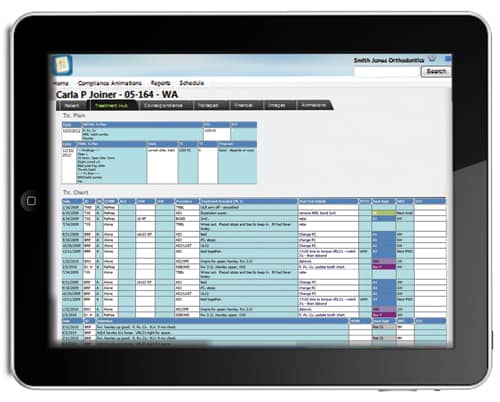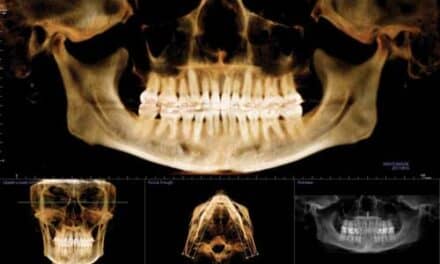As Craig Scholz, PhD, director of emerging technology at Ortho2, points out, almost anything you can imagine can be connected to the cloud—homes, cars, refrigerators. And the same is true of the orthodontic practice. Orthodontic Products talked to Scholz about how Ames, Iowa-based Ortho2 is helping practices engage fully with cloud computing and how the company’s mobile app development aims to take practice mobility to new levels.
Orthodontic Products: How has cloud computing matured in the healthcare sector, and specifically in orthodontics?
Craig Scholz: Adoption of cloud computing in healthcare has escalated significantly over the past few years, primarily due to the demand for increased availability and security of health records, cost reductions, and improved Internet infrastructure. A recent survey by HIMSS (Healthcare Information and Management Systems Society) estimated that 83% of healthcare companies are utilizing cloud computing. Eventually, all medical professionals with access to patient data will be required to utilize electronic medical and health records (EMR and EHR) and dental specialties won’t be far behind. Private cloud hosting solutions provide many advantages in complying with HIPAA, EHR, and PCI regulations over locally hosted server environments due to the level of security required by cloud vendors. In a recent article, one dentist called cloud computing an additional “HIPAA shield for your office.”
At Ortho2, we now have more than 2,200 orthodontic offices using our software, and we have seen significant growth in Edge, our cloud practice management system. Currently, more than 90% of all our new and converting customers choose our cloud-hosted Edge solution. A majority of the doctors purchase Edge because it can dramatically cut costs by eliminating pricey servers, Microsoft SQL, ongoing IT costs, and potential third party monthly fees. Also, as mobile devices such as smartphones and tablets have long passed PCs as the communication device of choice, mobile applications become paramount for the orthodontic practice, and we have built them seamlessly into Edge.
OP: What differentiates Ortho2’s Edge cloud?
Scholz: We began developing our cloud-based product, Edge, in 2006 and released it in 2010. At the time, it was the first cloud-based orthodontic management system on the market, and today it is thriving in its fifth version. Developing Edge from the ground up was no small matter, as we spent 4 years and more than $2 million building it. But it was worth it, as we can now fully leverage all that the cloud has to offer, including a variety of mobile applications and real time access to data. Of the top four orthodontic practice management systems, only Edge was designed and built from scratch as a cloud computing solution. The other systems utilize legacy software that was available long before the cloud. The overly inclusive use of the term “Cloud Computing” (sometimes called “cloudwashing”) is often used to try and conceal this fact, but over time the limitations of legacy systems will become increasingly apparent and more frustrating as new cloud-based functionality and applications are developed.
Edge is also unique in that it is extremely robust and includes everything you need to run your practice in one place. This is great from an efficiency standpoint since most of your software and support are coming from one place. For years, we had customers tell us they were tired of paying fees to third party companies and having to call them for support, so we made sure to include these services in Edge. Our Edge Complete System includes the standard management features like scheduling, charting, and reporting, but also includes modules like appointment reminders, patient rewards, a patient and doctor web portal, mobile applications, treatment and compliance animations, staff management resources, and our new office branded patient app called Practice Connect. Our overarching goals were to craft software that was exquisitely designed for the orthodontist, that was easy to use, and that helped to expand each office’s practice community. I believe we succeeded on all counts.
OP: How does Edge help orthodontists expand their practice community?
Scholz: With a true cloud-based platform, it is much easier to make your system accessible to anyone relevant to your practice. This can include you, your patients, their families and friends, staff, referrers, potential patients, and other treating specialists. By including modules and features that are easily accessible to members of your community, you are actively expanding your practice to them with very little effort on your part. Your goal is to reach as many people in your relevant community as possible and then engage them.
Our Practice Connect module is a great example of this. Practice Connect is an app that patients and
potential patients can download from the iTunes or Google Play stores, and provides them with a wealth of data about your practice. It is completely branded for your practice, so each office has a completely unique version. It works like an expertly developed website in a mobile app form. But even more than that, Practice Connect pushes data automatically—like a GPS login for appointments, real time rewards updates, and notifications that keep your patients engaged.
Similarly, by creating custom before and after videos with our Edge Animations and Premier Imaging modules and adding them to their Facebook page, practices report that they received exponentially greater views and likes. This kind of built-in branding and marketing goes a long way in today’s social media driven world, and greatly increases your exposure to prospective patients and your ability to engage them.
OP: Ortho2 has focused on mobile app development. What apps are currently available?
Scholz: Yes. Edge’s cloud platform gives us the ability to develop apps that exemplify the adage that “form follows function.” Rather than creating one basic software program to run on a computer, we can now create very specific functions to be performed on specific devices. We all see this in our home lives, where we use different devices (smartphone, tablet, computer, laptop, smart TV, smartwatch) based on the activity we are engaging in. This “device swapping” also happens in an orthodontic practice. Some tasks like scheduling and entering detailed chart notes are easiest to do on a computer, whereas online forms and watching treatment videos are best completed on a tablet, and patient access to their rewards is best on a smartphone. We’re excited to be developing apps that will take mobility to entirely new levels, significantly improving access of data and efficiencies of usage for everyone involved in an orthodontic practice.
Our Edge Complete System comes with mobile apps for the doctor, staff, patient, referrer, treating specialist, and potential patient. If you want the people in your community to connect with your practice, you need to make it as easy as possible for them to do so. This is exactly what Edge Mobile, Edge Animations, Edge Portal, and Practice Connect apps do for the office. In the fall of 2015, we released a version of our Edge Animations App with patient compliance videos and a new Introduction to Orthodontics videos that is free to all orthodontists and orthodontic residents. Interested doctors can download this app at no charge anytime at the iTunes or Google Play stores by searching Ortho2 Edge to experience some of the benefits of Ortho2 mobile applications.
OP: How do you choose and design a new app or Edge development?
Scholz: We keep our ear close to medical and dental market trends and to our customers, often in the form of our UserVoice system, which lets our customers request and then vote on new enhancements. Once we target an area to develop, we work closely with our Ortho2 Developer’s Conference group of orthodontists and consultants. And finally, we work with our Key Opinion Leaders such as Drs David Paquette, Sean Carlson, and Juan Carlos Quintero, who help keep us ahead of the curve.
As an example, our Key Opinion Leader group recently guided us in the development of a full 3D feature set within Edge to store, edit, and integrate CBCT data directly in the patient record. This functionality now allows doctors to store all their 3D files in the Edge cloud and operate within the patient record as opposed to a third-party software.
OP: What do you think is the next step for cloud computing in the healthcare/orthodontic space?
Scholz: I recently read that there are about 5 billion device connections to the Internet in the world today and that this is projected to increase to 30 billion connections in the next 4 years. Almost anything you can imagine will be connected to the cloud—homes, cars, refrigerators—everything! In orthodontics, we will see an increase in applications that connect these devices to specific functions in the cloud. At Ortho2, we are working on new integrations with intraoral scanners, 3D printers, telephony products, labs, and many other new orthodontic products and services. We are also developing new apps for the doctor to communicate with their data in the Edge cloud to do their treatment planning and charting, as well as other essential tasks. Eventually, I think we will also see VR (virtual reality) devices used for patient education and treatment simulations, as well as the use of wearables such as watches and glasses to further connect the doctor with their data. Ortho2 will continue to lead orthodontic software development in the cloud and we are excited to develop these new applications that will further enable orthodontists to manage and grow their practices. OP






